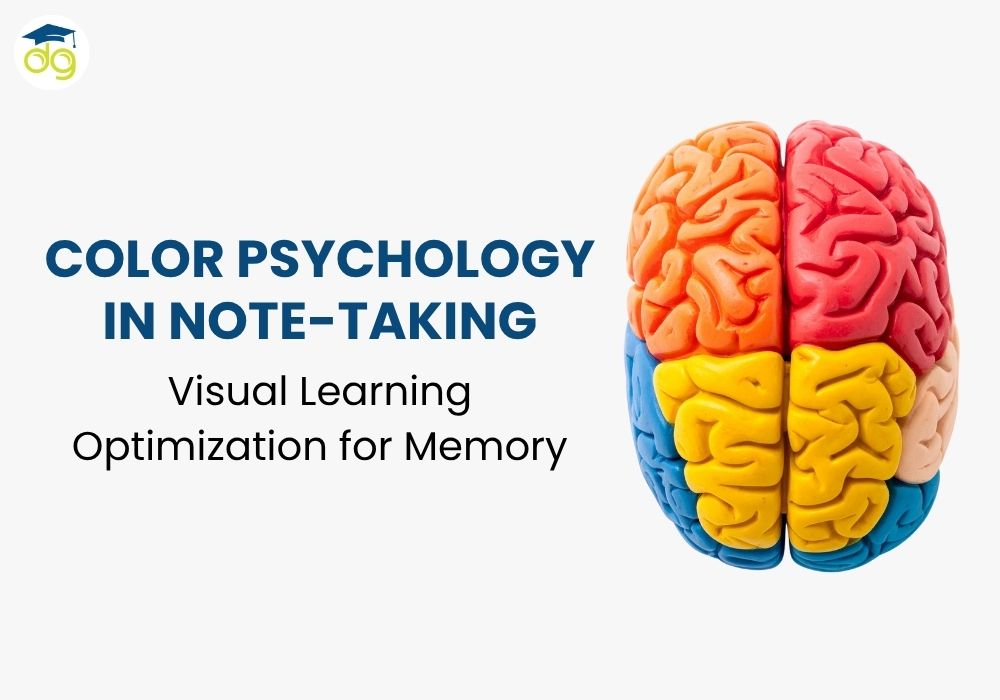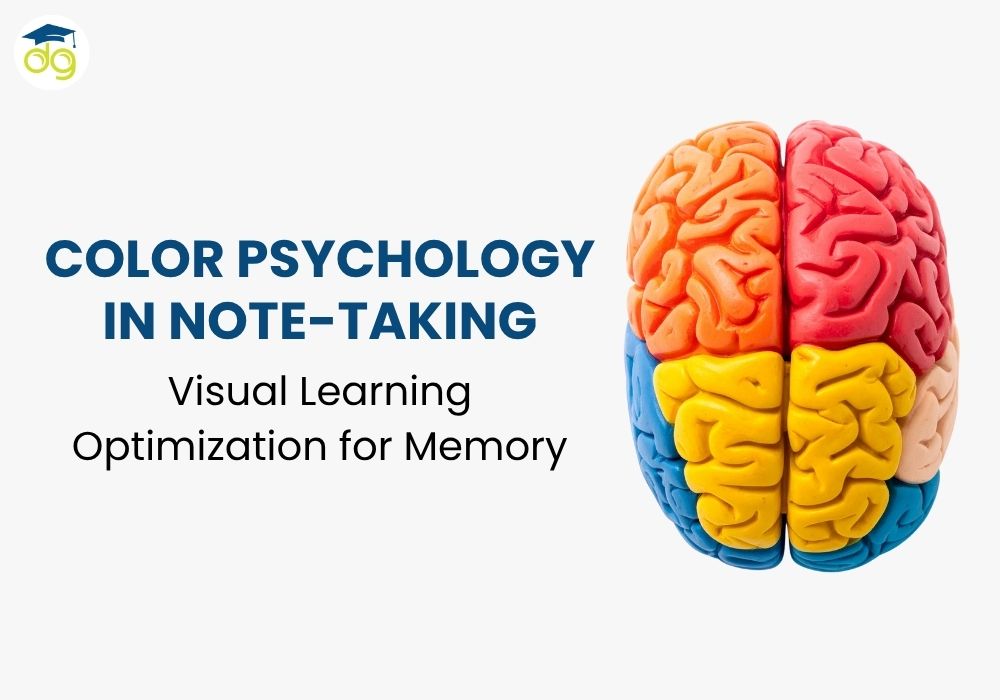Color Psychology in Note-Taking for Better Memory and Learning
How color-coded notes improve focus, recall, and visual learning efficiency
Everyone takes notes; however, not every student remembers the information in a timely manner. One of the least-known elements that improves notes' efficiency is color psychology..
If color is utilized in a deliberate manner it goes far beyond decoration. It transforms into a tool for learning. The idea of color psychology in note-taking examines the ways in which different colors impact mood, focus, ability to concentrate, and, ultimately, memory retention.
If you are a student who relies upon visual learning, Color-coded notes could alter the whole study process. Colors stimulate visual memory, enhance concentration, and make it easier for you to retain information during examinations. Learning through color could turn notes from a day into a powerful memory map.
Understanding Color Psychology in Note-Taking
Color psychology in note-taking refers to the study of the impact of cognitive processes of focus, comprehension, and recall. Different colors trigger various emotional and psychological reactions and affect the way students think and process information.
The brain detects color via the visual cortex. The visual signals trigger neural pathways to improve the ability to focus. Red, for instance, can boost alertness while blue helps to maintain calmness.
The colors can function like "anchors" that link specific hues to certain kinds of data. If a student revisits his notes, the brain associates the colors they have with specific meanings or concepts that make recall quicker and more logical.
The essence of color can be more than just a visual, but also a strategic one.
The Connection Between Color and Visual Learning
The learning styles of learners vary; however, the majority of students have visual learning--those who learn best by using diagrams, images, or color-coded layouts.
If students use colors in their notes, the brain processes this information in a way that is visual and not simply words. This improves visual learning through linking information to visually identifiable patterns.
The research suggests that visuals enhance understanding and retention by up to 60 percent. In the event that color is added to the picture to the mix, it boosts engagement and improves retention.
Color transforms the static text into vibrant and memorable visuals. Color helps students not just retain what they learned but also remember where on the page that information came up, which is a phenomenon known as spatial recall.
How Does Color Impact Memory and Learning
The effect of colors in memory and learning is due to their capacity to draw attention and assist in the organization of information. The brain is a lover of patterns, and colors offer an orderly feeling.
If students are using multiple shades for their notes, they make clear distinctions between different types of content, such as definitions, examples, and formulas. The clarity of notes improves the processing of the brain's information and is vital to memory retention..
The research suggests that color can enhance learning
- Focusing attention on the most important information.
- Reduces monotony in long studies.
- Strengthening associations between different topics and visual clues.
As an example, if highlighting red indicates formulas, your brain starts to associate the color red with "important equations." When studying, similar visual signals immediately bring attention to the most important ideas, which leads to better retention during tests.
The Best Colors for Note-Taking
Each color has its own identical psychological impact. Each color has a unique influence upon the mind.
Below is a table that lists the best colors for note-taking and the psychological benefits they bring:
Color | Psychological Effect | Best Use in Notes |
| Blue | It calms the mind and helps improve concentration. | Make use of them for headings that are the main focus topics, theoretically-oriented subjects, as well as rational explanations |
| Green | Enhances clarity and balance | Ideal for diagrams, examples, or other content that supports them. |
| Red | Enhances attention and alertness | Make sure to use sparingly when defining the definitions, words, or formulas |
| Yellow | Increases confidence and improves visibility | Ideal for quick highlights or reminders |
| Purple | Increases imagination and creativity | Great for brainstorming ideas and conceptual maps |
| Orange | Invigorates and stimulates | Ideal for motivational notes |
How to Use Color Coding in Study Notes
Color coding is among the most efficient ways to arrange data visually. It provides structure, order, and clarity to notes. An organized system not only improves note organization methods but also improves memory.
Step 1: Choose a Purpose for Each Color
Give a particular meaning to each color. Example:
- Blue for headings
- Green to show examples
- Red for definitions
- Highlights in yellow
Step 2: Stay Consistent
Use the same method across all individuals. In the event that your brain keeps encountering similar color patterns that it helps to build longer-term visual memory.
Step 3: Use Moderation
Do not use excessive colors on a single page. Your goal should be clarity, not a showpiece.
Step 4: Mix with symbols
Combine colors using the use of underlines, arrows, or even stars to draw attention between subjects.
Step 5: Review Visually
In revision, color-code notes for faster recall of information instead of rereading text paragraphs.
Using Colored Pens Improves Memory Retention
Using colored pens can have a tangible impact on memory retention. Handwriting is already a way to activate motor memory in the brain. If color is added to the writing, the brain is stimulated by the visual memory and creates a more powerful connection between the brain and.
The results of studies have revealed that pupils using blue or red ink tend to be more able to recall details than those writing in gray or black. Blue helps focus and improves comprehension, and red increases attention to detail as well as recall precision.
Simply put, color assists the brain in "tagging" information. Each color functions as a memory marker, which helps you remember information during tests or during discussions.
Which Stationery Items Are Best for Color-Coded Notes?
The effectiveness of color psychology in note-taking is also dependent on having the correct stationery for students. Digital or handwritten, having a proper materials color coding process is seamless.
This is a brief guide on the most important stationery items:
Stationery Item | Purpose | Usage Tips |
| Colored Pens | For categorizing ideas or even sections | Apply 3-5 shades to ensure clarity |
| Highlighters | In order to mark crucial points or phrases | Utilize pastels or shades of yellow for subtle accents |
| Sticky Notes | To quickly remind you or to add details | Give each person a particular colored sticky note |
| Tabs/Labels | For dividing topics or chapters | Use bright colors for quick visual identification |
| Colored Index Cards | Revision and flashcards for use with flashcards. | Use distinct colors for questions vs. answers |
Apps for digital students, such as Notion, GoodNotes, and OneNote, offer virtual versions of color-coded notes, which allow an easy organization process and access.
Study Techniques Using Color for Visual Memory
Colors are a potent tool for visual learning and memory enhancement. Below are some study techniques using color that optimize visual memory strategies:
A. Thematic Highlighting
Give color themes to the subjects or chapters. As an example, science textbooks use blue and green; history is a mix of brown and yellow. Color consistency in the theme can help strengthen the association of notes and increase recall.
B. Mind mapping using Colors
In creating mind maps, you should color every branch with a distinct color. The visual contrast increases the clarity of concepts and also helps students recall connections between ideas.
C. Dual Coding
Combining visuals (like diagrams and infographics) along with text by with matching colours for each. In the example above, if an image's label is red, you should write its description in red as well. It bridges the text-image divide to make it easier for you to remember the information.
D. Color-Based Revision Schedule
Color-coded planners can help you prioritize studies. It is possible to mark urgent areas with red, while green may indicate completed ones, and yellow may indicate areas in need of review.
E. Flashcard Color Differentiation
Make flashcards using color-based categorization: blue for definitions, orange to show instances, and green for the most important words. This provides a visual aid to the traditional method of learning.
Common Mistakes in Color-Coded Note-Taking
Although color-coding can be extremely beneficial, it could cause harm if done incorrectly. Many students make the error of transforming their notebooks into rainbow palettes, and this can create confusion rather than clarity.
There are common traps to steer clear of:
- Inappropriate use of colors - A lot of shades make the pages look cluttered.
- Unconcordant color usage - changing systems often can confuse the brain.
- Ignoring legibility - Dark or bright inks could affect readability.
- Focusing on aesthetics - Notes need to be practical, not attractive.
The most effective note-taking method is to use simplicity. Each color should have an obvious purpose and be in line with the understanding and goals for retention.
Color Psychology in Digital Note-Taking
As online learning becomes more widespread, digital note-taking applications have been adapted to incorporate color-coded options. Platforms such as Notion, OneNote, and Google Keep allow users to create color tags, highlighters, and folders that mimic the effect of physical color-coding.
Digital color codes help organize and facilitate the rearrangement of notes, particularly when it comes to collaborative projects and interdisciplinary research.
But the same rules are applicable:
- Use a consistent palette.
- Beware of bright, intense colors that can strain your eyes.
- Prioritize structure over design.
This technique helps learners retain the advantages of the psychology of color in note-taking as they embrace the latest technology.
Example: A Color-Coded Note Layout
For a demonstration of how colors arrange information, here's an easy illustration:
Section of Notes | Color Used | Purpose |
| Main Headings | Blue | Relaxed focus and structure |
| Definitions | Red | Instant recall cue |
| Examples | Green | Balance and understanding |
| Key Points | Yellow Highlight | The emphasis and the visibility |
| Formulas or Dates | Orange | Awareness, energy, and vitality |
Final Tips for Effective Color-Based Note-Taking
Students who want to master color-coded notes. These are the best suggestions:
- Make it easy. Choose a limited color palette.
- Make sure you are consistent. Use the same design throughout every note.
- Revision visually. Scan colors before tests to prompt memory.
- Combining color and structures. Use bullet points, spacing, and tables.
- Explore. Find what color combinations are most effective for your individual preference for learning.
If used properly when used properly, it transforms notebooks into powerful visual memory tools that encourage active involvement and sustained learning.
Conclusion
Color isn't just an aesthetic feature; it's also a learning stimulant. The use of color in an intelligent manner helps students improve their visual learning, improve their concentration, and make learning fun.
Utilizing color psychology in note-taking, learning, students can draw on the brain's inherent capacity to recall, associate, and efficiently organize data. Through highlighters, pens, or other digital devices, colors help transform complicated subjects into captivating visual tales.
As we move towards better learning, colors aren't just an accessory; they're a benefit.
From tips for studying to personalized learning insights, SkoodosBridge connects learners with all the tools and information to help them achieve academic success. Learning smarter. Remember longer. Better your results with SkoodosBridge.
FAQs
1. How does color impact memory and learning?
Colors improve memory and learn by bringing attention to important aspects, enhancing focus, and helping the brain categorize data. The visual stimuli aid in recall when revising or taking exams.
2. What are the best colors for note-taking?
Green and blue are most effective for focusing and understanding, while red is great to help recall, and yellow is for highlights. It is important to use the same colors across different subjects.
3. How to use color coding in study notes effectively??
Assign every color a purpose, for instance, blue is for the headings, red for examples or definitions, and green to highlight the word. Limit yourself to 3 colors and make sure you use them regularly for better visual memory.
4. Does using colored pens improve memory retention?
Absolutely. Research has shown that those using colored pens, specifically red and blue, tend to keep information longer when compared to those who simply use grey or black ink. Colours help make notes more enjoyable and easier to recall.
5. Which stationery items are best for color-coded notes?
Colored pens, highlighters, sticky notes and tabs work well for notes that are color-coded. These instruments help students manage their notes visually and help make revision more efficient.
Categories
Archives
Similar Posts

Color Psychology in Note-Taking for Better Memory and Learning
by Skoodos Bridge

Mirror Neurons and Group Study: The Psychology Behind Collaborative Learning
by Skoodos Bridge

Music Therapy for Concentration: Playlists to Boost Focus While Studying
by Skoodos Bridge

Dopamine Hacking for Study Motivation: Neuroscience-Based Exam Prep
by Skoodos Bridge

Electric Vehicle Jobs: Top Mechanical Engineering Careers in EV Sector
by Skoodos Bridge

EdTech Careers After Engineering: Build Learning Apps & Startups
by Skoodos Bridge

Gaming Meets Medicine: VR Therapy Careers for NEET Aspirants
by Skoodos Bridge

WhatsApp Group Study: Boost Your Competitive Exam Preparation
by Skoodos Bridge

Drone Engineering Careers: Aerospace Pathways, Exams & Job Opportunities
by Skoodos Bridge


Leave a Comment